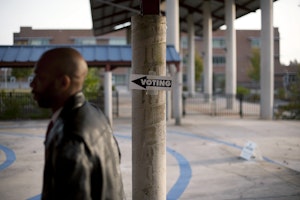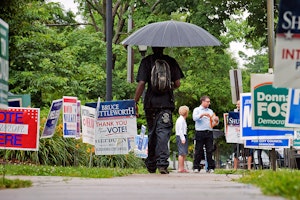The Most Powerful Tool to Defend Minority Voting Rights Is Gone
By Laleh Ispahani
Last Tuesday, the U.S. Supreme Court issued its ruling in Shelby County v. Holder, determining that a key provision of the Voting Rights Act of 1965 is unconstitutional. And just like that, we lost the most powerful tool to defend minority voting rights and fight vote suppression.
The Voting Rights Act declares discrimination in voting unconstitutional and provides certain tools to redress discrimination, the most valuable of which is found in Section 5 of the Act. That tool is a preapproval process that requires some or all of 15 states with histories of discrimination in voting to seek approval from the federal government before making any proposed voting changes to ensure they will not be discriminatory.
The areas covered by that provision were determined by a coverage formula that was last updated in 1972. Through Section 5’s powerful deterrent effect—local officials knew that their actions would be reviewed and as a result—much bad activity was deterred. Between 1999 and 2005, 153 voting changes were withdrawn and 109 superseded by altered submissions after more information was requested. There’s no dispute that this statute has been enormously successful.
In the 5-4 decision, five justices didn’t explicitly declare Section 5 unconstitutional, but by declaring the formula on which it was based unconstitutional, they effectively neutered what one scholar called “the crown jewel of the civil rights movement.” If there is no coverage formula, by definition there can be no preclearance. As Jeffrey Toobin told CNN, the Court did this on the grounds that “times have changed so much that the formula [for deciding which states are more prone to discriminate] is invalid.”
This decision is therefore a great act of judicial overreach. The court gave no deference at all to Congress’s judgment as to where the problem was and what the remedy should be. The Court overruled a Congressional Act that was reauthorized five times since it was first enacted, each time by overwhelming majorities in both chambers of Congress (98-0 in the Senate and 390-33 in the House, in 2006). The last time the Act was reauthorized, Congress amassed a 15,000-page record supporting its judgment that minority voters in certain places needed specific protections so they could participate equally in the political process.
As Justice Ginsberg wrote in her dissent, “With overwhelming support in both Houses, Congress concluded that, for two prime reasons, [Section 5] should continue in force, unabated…. First, continuance would facilitate completion of the impressive gains thus far made; and second, continuance would guard against back sliding. Those assessments were well within Congress's province to make and should elicit this Court's unstinting approbation.”
Section 5 was instrumental in protecting against many egregious changes proposed in the run up to the 2012 elections, when it blocked efforts to suppress the votes of millions of voters of color in Florida, Texas, and South Carolina. In the past 25 years, Section 5 of the Voting Rights Act has stopped over 1,000 proposed discriminatory voting changes—from statewide voter registration procedures that made registration particularly difficult for minority voters, to localized changes in the methods of election that would dilute minority voting strength.
Its greatest value may have been to protect minority voters at the sub-state level, in elections few if anyone notices: About 85 percent of Section 5’s work was to check changes proposed in parishes, towns, cities and counties that affected mayoral, school board and other local elections; elections in which polling locations are suddenly reduced, moved or closed; elections cancelled after minorities become the majority of voters; and other tactics.
And what happened in the 48 hours following Shelby proves that the jurisdictions covered by the now unconstitutional formula haven’t gotten the point. The Department of Justice had blocked a clearly discriminatory voter ID law in Texas last year; two hours after Shelby decision the Texas attorney general announced the state would put the law into effect. Four other states have followed suit.
Photo ID laws passed in recent years in Alabama, Mississippi, and Virginia, which had not yet obtained federal pre-approval, can now go into effect without undergoing Section 5 scrutiny. Other states will also advance new voting restrictions. North Carolina legislators, citing the Court’s decision, could begin voting next week on a series of curbs, including a photo ID requirement, reducing the early voting period, and eliminating same-day registration.
While the Supreme Court’s decision is a great setback, it left open the possibility for Congress to update the coverage formula. And it is feasible to design up-to-date and adequate protections. Advocates are already busy analyzing the remaining tools (state constitutions, other federal statutes, and other parts of the VRA) to forge new protections for vulnerable voters in litigation challenges; examining policy alternatives; and planning to mobilize. Congress must act fast to pass a new coverage formula, and unless it does, millions of minority voters will be vulnerable in ways we haven’t witnessed in almost 50 years.
What the decision underscores is the importance of which judges sit on the bench. In the last few years alone, federal judges have shaped policy from climate change, health care, labor relations, contraception, gun control, campaign finance, and now the fundamental right to vote. While Congressional action often gets bigger headlines, federal judges often have the last word. So, as we move forward, we also need to focus on improving the federal judicial nominations process. We need on our benches demographically and ideologically diverse judges who reflect the society they are from.
Let’s not forget that voter suppression cases are increasingly argued in state courts. In the wake of this decision, we will see even more state court litigation. We elect judges in most states, and since the Supreme Court’s decision in Citizens United and the Speech Now decision, we are seeing record levels of spending in judicial elections.
Together with unprecedented efforts to suppress the minority vote and the flood of money into state judicial elections, the Shelby decision also underlines the need to keeping our state courts fair and impartial and to keep the interests of a wealthy few from suppressing the votes of racial minorities. Indeed, when the Pennsylvania Supreme Court blocked voter ID for the November 2012 elections, a local Tea Party group immediately announced that they would target Chief Justice Castile in the next judicial election. And voter ID was a central issue in the April 2013 Wisconsin Supreme Court race, with the Huffington Post reporting that those seeking to protect voter ID (along with other conservative causes) had devoted substantial resources to the race.

Laleh Ispahani is executive director of Open Society-U.S.


